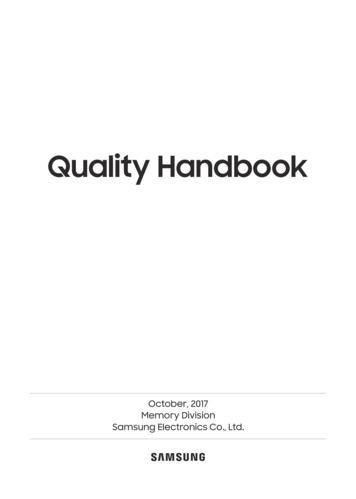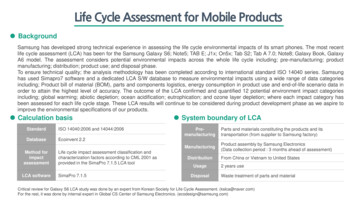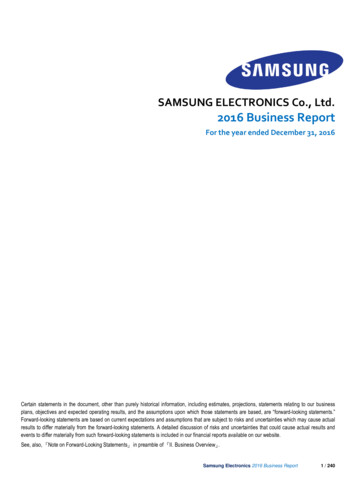
Transcription
Quality HandbookOctober, 2017Memory DivisionSamsung Electronics Co., Ltd.
Disclaimers:SAMSUNG ELECTRONICS CO., LTD. AND ITS AFFILIATES (COLLECTIVELY, “SAMSUNG”)ASSUMES NO LIABILITY WHATSOEVER, AND SAMSUNG DISCLAIMS ANY EXPRESS ORIMPLIED WARRANTY, ARISING OUT OF OR RELATED TO THE INFOMRATION CONTAINEDHEREIN AND YOUR PURCHASE, APPLICATION AND/OR USE OF SAMSUNG PRODUCTSINCLUDING WARRANTIES RELATED TO FITNESS FOR A PARTICULAR PURPOSE,MERCHANTABILITY, OR NON-INFRINGEMENT.THIS DOCUMENT IS PROVIDED FOR REFERENCE PURPOSES ONLY, AND ALL INFORMATIONDISCUSSED HEREIN IS PROVIDED ON AN “AS IS” BASIS, WITHOUT WARRANTIES OF ANYKIND. SAMSUNG ASSUMES NO RESPONSIBILITY FOR POSSIBLE ERRORS OR OMISSIONS,OR FOR ANY CONSEQUENCES FROM THE USE OF THIS DOCUMENT.This document and all information discussed herein remain the sole andexclusive property of Samsung. Except your limited right to use this documentfor internal evaluation purpose, no license, express or implied, by estoppelor otherwise, to any intellectual property rights is granted by this document.Samsung makes no commitment to update the information contained in thisdocument, and Samsung reserves the right to change this document at anytime without notice.All brand names, trademarks and registered trademarks belong to theirrespective owners.Copyright 2017 Samsung Electronics Co., Ltd. All rights reserved.2
Table of ContentsQuality Policy5Quality Management System5Supplier/Sub-contractor Quality Management10Customer Service133
Revision HistoryDateVersionRemark17.10.2000Quality Handbook Rev004
1. Quality PolicySamsung Memory Division (“Samsung”) is continuously striving to achieve the best quality in all productsand services in order to meet customers’ requirements and expectations. It is Samsung Quality Policy,based on an effective quality management system to ensure delivery of the best products and services.2. Quality Management SystemThe Samsung’s Quality Management System (QMS) meets the requirements of ISO 9001, ISO/TS 16949and also our customers’ requirements. The manager of the quality team sets annual quality goals toexecute the quality policy and the activities with respect to the quality policy. Goals are shared with alllevels of management involved with the quality management system.2.1 CertificationsAll domestic and overseas semiconductor sites have acquired the ISO 9001 certification. The memorybusiness acquired the QS 9000 in 2002. Samsung has led the industry in quality standards for thesemiconductor industry since 1993 when the company first received top-level (ISO 9001) certificationof its plants in Korea. To date, Samsung has by far satisfied consumer requirements through its broadrange of quality management system certification such as ISO 9001 and ISO/TS 16949.Certificate Milestones 1993 ISO 9001 for semiconductor plants in Korea1999 ISO 9002 for semiconductor plants in Austin, Texas and Suzhou, China1999 QS 9000 for System LSI plants in Korea2001 TL 9000 for semiconductor plants in Korea2002 QS 9000 for memory plants in Korea2004 ISO/TS 16949 for semiconductor plants in Korea Substituted TS 16949 for QS 90002005 ISO/TS 16949 for semiconductor plants in Suzhou, China2008 ISO/TS 16949 for semiconductor plants in Austin, Texas2014 ISO 9001 for semiconductor plants in Xian, ChinaImplementation HistoryISO/TS 16949ISO 9001Korea - Kiheung,Hwaseong, OnyangUSA - AustinChina - SuzhouChina - XianDesign, Fabrication,Assembly and Test ofMemory, System LSISemiconductorAssembly and Test ofSemiconductorFabrication of MemorySemiconductorFabrication of MemorySemiconductor5
2.2 Quality Documentation SystemThe objective of Samsung’s quality management system is to establish and maintain a documentedquality system which is defined to ensure that the products and process conform to specifiedrequirements and meet the requirements of ISO 9001 and Automotive requirements.All employees are committed to the concept of “No Spec, No Work” and performing all applicable qualityimprovement activities on a continuous basis. Samsung’s quality documentation system is comprised ofa document structure hierarchy.The purpose of the Quality Manual is to specify the requirements of the quality management systemof Memory Business in order to satisfy the requirements of ISO/TS 16949, statutory and regulatoryrequirements as well as customers' requirements and to ensure that all members of the organizationinvolved in the quality management system implement the quality policy.Procedure describes role and responsibility and work processes by each department to implement thequality management system components.Instruction describes skills and methods that are needed to implement the work processes defined bythe procedure.2.3 Audit ProgramSamsung has set up and is operating the Audit Program by each manufacturing site, to upgrade thelevel of the quality management systems by creating a desirable culture of objective diagnosis andimprovement.Memory business has organized quality teams for the purpose of auditing quality management systemto insure that the policies and specifications set forth by the company are followed. There are differentaudits performed at the manufacturing site on a routine and non-routine basis.Preventive AuditThe preventive audit is performed on a regular basis. The purpose of this type of audit is to insure that majordepartment throughout the division follows the general policies of the company, and the division follows thegeneral policies of the company that concern the quality management system for Memory business. If anyproblems are found, the department is cited and required to produce a corrective action.Non-scheduled AuditThis audit is performed on a random basis unannounced to check process areas and their personnel for theirconformance to company quality policies and/or specifications. Operators and equipment as well as theprocess itself will be audited at this time. Typically the audit is requested when a problem arises in a process.If any problems are found, then the department is cited and required to produce a corrective action.2.4 Continuous EffortsSamsung makes every effort to achieve excellent and consistent product quality at fair prices, and at theright time to ensure customer satisfaction. In order to achieve this goal, Samsung continuously improvesproductivity by controlling the variation in various processes in a stable way. Continuous improvement isimplemented by a closed loop methodology consisting of a selection of critical parameters, evaluationof the measurement system, monitoring of critical parameters, process capability improvement, andreaction plan. The main purpose of the CIP activities is minimizing the variation around the target.6
Real Time Monitoring (Activities for Special Causes)Interlock System : Products and processes are monitored and controlled by automatic interlock systemsthroughout the manufacturing process. In FAB, a three stage protection system is working : Process RecipeInterlock (Incoming Materials and Recipe Check), Equipment Parameter Interlock and Process Output Interlock.At wafer sort, wafers are statistically monitored based on various test results and yields before assembly.Statistical Process Control (SPC) and Advanced Process Control (APC) : An advanced SPC system suitablefor semiconductor manufacturing processes has been implemented and used for random trend monitoring.It includes small change detecting, particle, and multivariate SPC modules. Also, the APC system includingreal time control and run-to-run control is successfully used for controlling deterministic process behaviors.Company-wide Improvement Projects (Activities for Common Causes)FAB Equivalency - "Copy Intelligently" : Samsung Equivalence Test program checks the equivalency and nonequivalency of measurement data of output characteristics from "Copy Intelligently" activities. Its purpose isto lead us to make an action to standardize the output characteristics between lines or equipment.Statistical Post Processing : Statistical analysis of test results at wafer sort not only optimizes test effort butalso gives useful information such as potential reliability and yield. With a help of statistical approach, wafersor dies with latent risks can be effectively screened and dies can be binned according to potential risks.Virtual Metrology and Modeling : Virtual metrology is of great interest in semiconductor manufacturingprocess. The idea is to construct predictive models that can forecast the electrical/physical parameters ofwafers based on data collected from processing equipment. In this way, actual measurements from waferscan be minimized or eliminated. Furthermore, the APC combined with virtual metrology will lead to a shiftfrom "Lot-to-Lot control" to "Wafer-to-Wafer control".MSA (Measurement System Analysis)Measurement System Analysis is performed to quantify statistically the uncertainty of the measurementsystem (component elements including the measurement environment and sample as well as mechanicaldevices, measuring methods and people are evaluated. This is to control the stability and integrity ofmeasure of process parameters of product characteristics from both the short and long-term perspective.MSA procedures are as follows:7
[ Figure 2-4 MSA Procedure ]FMEA (Failure Mode and Effects Analysis)Failure mode effect analysis is a method used for checking if measures are taken against every possiblefailure in the design, the manufacturing process, the operating method, etc. For this analysis, factors suchas design, manufacturing process, packaging, and operating method are divided into small units, and itsfunctions are clearly defined. All possible failure modes are listed for each item. The effect on the product andthe cause of each failure are examined. Each item is then evaluated to clarify the corrective action to be taken.Samsung performs Design FMEA at a stage of design and Process FMEA at a stage of manufacturing stage.2.5 Nonconforming products controlIf nonconforming products (products which deviate from the specified) develop during process, theprocedures for handling the nonconforming products and preventing the recurrence thereof requireidentification, isolation, and corrective actions. The ALPS computer system (ALPS: Abnormal LotsProcessing System) is being set up which can handle the notification of nonconforming productoccurrence, investigation of the cause, establishment of countermeasures, handling instructions, andapproval procedures immediately upon occurrence thereof.8
[ Figure 2-5 Procedures for Handling Nonconforming Products ]2.6 CalibrationThe purpose of calibration is to provide a system whereby, production and test equipment parametersare correlated to Samsung standards via internal and external calibration methods.Calibration of manufacturing and test equipment is the responsibility of the respective processengineering and test engineering departments. It is conducted by either calibration engineering or anexternal service organization. Equipment used for piece parts, incoming raw material, in-process qualitymeasurement, final acceptance, and batch release of product, require calibration.Procedure1) Calibration is conducted by qualified personnel only. Comprehensive specifications forprocedural methods are made available for complex instrumentation systems.2) A calibration record contains reference to :a) Operational and calibration statusb) Frequency of calibrationc) Dates applicabled) Personnel involved3) In addition to an individual calibration record for each piece of registered equipment, aDisplay chart showing the current calibration status of all registered equipment ismaintained.9
※ NIST : National Institute of Standard Technology, IAA : Industrial Advancement Administration, KRISS : Korea Research Institute of Standards & Science.[ Figure 2-6 Traceability of standards ]2.7 Product Regulation CertificationDeclarations of Conformity for SamsungSamsung has gone to great lengths to achieve and maintain compliance with standards and regulationssuch as CE marking or CB. By complying with industry standards, we are able to quickly adapt to changes inthe industry for our customers.Regulations covered by region:European Union - CE marking, CBUSA – EMC, Safety certificationCanada, Australia, New Zealand - EMC certificationOther regions:Certain countries might require extra certifications that are not listed here. For more details orcountry-specific approvals applicable to the specific product, consult your regional representative.3. Supplier/Sub-contractor Quality Management3.1 Material QualificationThis ensures that materials of good quality are supplied by certifying the quality based on proceduresconcerning materials. Samsung makes its utmost efforts to secure high-quality raw materials frommaterial suppliers to meet manufacturing requirements. To meet material requirements, Samsungoperates a material quality management system to ensure raw material quality. The material must satisfyquality and reliability requirements, specification requirements including validation, and yield targets ofSamsung.10
[ Figure 3-1 Supplier & Material Qualification Procedure ]To maintain excellence material quality and treat material-related issues, Samsung operates variouskinds of control plan.Prevention Change Control Board Failure Mode & Effect Analysis (FMEA) Audits Technical Review Meeting (TRM)Detection Supplier Statistical Process Control (SPC) Supplier Outgoing Quality Control (OQC) Samsung Incoming Quality Control (IQC) Material Quality MonitoringReaction Supplier Corrective Action Request (CAR) Material Review Board (MRB)Prevention : To prevent material-related quality issues, Samsung operates issue preventative tools.Change control board controls and evaluates intended quality changes from suppliers. Failure Mode andEffect Analysis (FMEA) is used as a tool to define potential causes of quality issues and establish effectivecounterplans in advance. Samsung performs audits on supplier’s overall quality management system andmanufacturing process including SCM capacity, purchasing, and storage management.Detection : To detect material-related quality issues and to control propagation of issues, Samsung usestools such as material inspection based on statistical process control (SPC), and advanced metrology system.Suppliers are requested to support these process control actions and Samsung offers consultation andtraining including seminars to suppliers if necessary.Reaction : Suppliers are responsible for corrective actions following material-related quality issues. Samsungoperates Material Review Board to find the true cause of the issues and set-up preventative action plans.11
Supplier QualificationTo qualify as a new supplier of Samsung, the certification supervising department evaluates the engineeringcapability, product stability, and R&D capability by reviewing the documents and may request the necessarysupplementary materials from the supplier. Samsung quality audit is carried out based on the vendor qualityaudit procedures.Supplier EvaluationSamsung evaluates quality, technology and purchasing performance of suppliers and vendors in thetransaction of primary subsidiary materials. Evaluation department apply Penalty & Incentive rule toSuppliers as negotiation with procurement and quality team.3.2 Sub-contractor quality assurance (Quality/Engineering)Sub-contractor QualificationThe System under which a Qual Plan is established when the events requiring subcontractor Qual occurSubcontractor changes requiring Qual are new PKG/new equipment/process/raw materials. The conformityof subcontractor mass production process is subjected to technical review conducted by the EngineeringDept. The Subcontract Quality Dept. supervises the activities required for evaluation qualification, andapproval of a Subcontractor production process.[ Figure 3-2 Sub-contractor qual procedure ]12
Subcontractor Nonconformity Products ControlNonconformity product handling (Subcontractor part): Procedure for taking corrective actions for the Lotswith yield below the standard due to Device characteristics are established. Test is conducted at Onyangafter Assembly of subcontractor semi-finished products. Product which can affect the reliability, quality andField due to defect caused when process characteristics quality is evaluated.Subcontractor Rating & Ranking (S.R.R)PurposeTo conduct a periodic and an objective evaluation of all activities of subcontractors related to the qualityto ensure efficient and systematic control of all subcontractors of Samsung, thereby improving the qualitylevel of subcontractors through actions for business and follow-up control based on the rating & ranking byquality evaluation.Evaluation methodAbsolute evaluation by 5 Ratings & Rankings (A-E) weighted per item by category of items related to thequality activities.Items: Quality audit, Process nonconformity, Customer complaint, CIP, CPK etc.Follow-up actions per rating & ranking by evaluationDepending on the rating and ranking by evaluation (A-E), follow-up actions including but not limited toadjustment of subcontract volume for the next year's subcontract agreement, extension of agreementduration, and support for quality improvement would be taken to encourage subcontractors to makecontinuous quality level improvement.4. Customer Service4.1 Customer SatisfactionFor customer satisfaction, Samsung regards interactions with our customer as the highest priority andperforms a variety of technical and proactive quality collaborations such as Qualification Support,Quality Improvement, and Problem and Requirement Management. Having its newest long-termmaster plan for “Quality Design” in place, Samsung will create a symbiotic business environment toensure the Highest Quality of Customer Service.VOC ManagementSamsung actively listens to the voices of customers using various channels, including R&R, periodic qualityreview meetings, or surveys or interviews on specific customers, and analyzes the obtained data in an effortto provide customers with products and services of the highest quality by driving a sustainable qualityinnovation movement.13
4.2 Claim ManagementThis flow demonstrates the failure analysis procedures for maximization of customer satisfaction whichstarts from receiving quality claims, analyzing them, devising countermeasures to taking correctiveactions by exactly identifying customer dissatisfaction with the products and thus effectively handlingclaims and preventing the recurrence of the same problem, thereby securing good product quality andcredibility.[ Figure 4-2 Failure Analysis Procedure ]4.3 RMA(Return Material Authorization)This is a series of steps by which problems that mayoccur with Samsung‘s products that have alreadybeen shipped to customers or warehoused forshipping are being identified and handled promptly.The objective is to minimize quality issues byresponding to customer’s quality-related requestsquickly and timely.[ Figure 4-3 RMA Procedure ]14
RecallThis refers to a process by which Samsung notifies its branches or customers of any quality issues found byits internal quality monitoring system. In rare cases, Samsung will have its branches or customers to returnproducts with quality issues to the designated places to take care of such quality issues effectively.4.4 PCN (Process Change Notification)Product/Process changes allow Samsung to improve product quality and manufacturing efficiency aswell as customers’ flexibility. These changes can include new or different types of materials, designs orprocesses. Samsung has a PCN procedure for any major or critical changes to its process. By followingthis procedure, the customer is able to be notified before any major or critical change is made to theprocess.[ Figure 4-4 PCN Procedure ]15
AbbreviationsTerminology or AbbreviationsDefinitionQMSQuality Management SystemSPCStatistical Process ControlMSAMeasurement System AnalysisFMEAFailure Mode and Effects AnalysisALPSAbnormal Lots Processing SystemNISTNational Institute of Standard TechnologyIAAIndustrial Advancement AdministrationKRISSKorea Research Institute of Standards & ScienceAPCAdvanced Process ControlTRMTechnical Review MeetingOQCOutgoing Quality ControlIQCIncoming Quality ControlCARCorrective Action RequestMRBMaterial Review BoardSRPSubcontractor Rating & RankingFAFailure AnalysisRMAReturn Material AuthorizationPCNProduct/Process Change Notification16
The Samsung’s Quality Management System (QMS) meets the requirements of ISO 9001, ISO/TS 16949 and also our customers’ requirements. The manager of the quality team sets annual quality goals to execut











